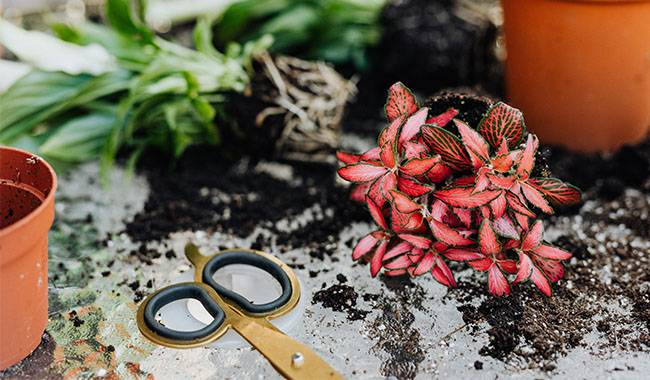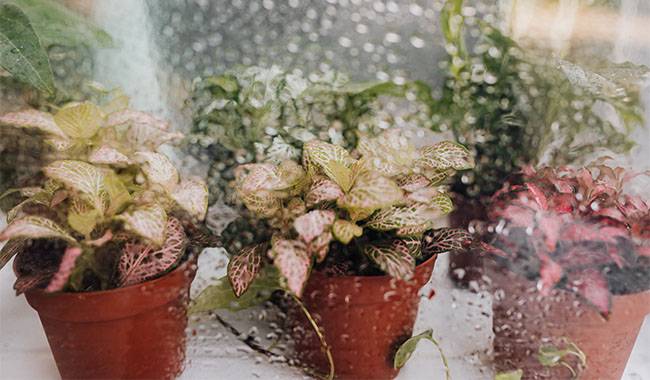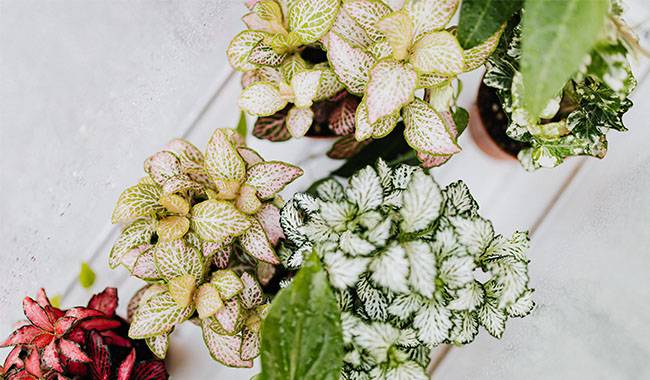
Fittonia, the delicate indoor wonder, is a plant with character. This is mainly reflected in its watering requirements. Generally speaking, Fittonia is not the easiest plant to care for. However, in general, it is sufficient to meet its tropical requirements regularly in order to avoid problems. Fittingtonia mistakes are easily avoided if simple rules of care are followed. Careful and attentive observation of the plant is the main secret of success. But it is not the only one. You will learn How to Care and Grow Fittonia Plant in the ThumbGarden article.
FITTONIA PLANT DESCRIPTION
Fittonia is a member of Acanthus, a herbaceous ground cover plant native to the tropics. They are most common in the flora of Peru. From mats in small pots to entire clumps in greenhouses and waterfalls in amperes, they can grow as far as the volume and shape of the container will allow.
The short, slender stems are invisible beneath the mass of foliage. Light or dark, with shades ranging from olive and swamp to emerald and purple, the leaves are decorated with a dense network of light patterns that highlight each vein. They can be white, cream, pink or silver.
Fittonia is often referred to as the most beautiful indoor perennial. In recent years, it has really become a real favorite among designers, as there is room for it in even the smallest of offices. However, the secret to Fittonia’s popularity lies in other ways.
The plant’s foliage texture is so unique that even its difficult character is forgiven. It was once considered a crop for collectors only. Breeding has slightly (if not completely) altered Fittonia’s characteristics to make it more tolerant, but it has still become uncomfortable to grow.
To avoid making major mistakes when cultivating Fittonia, and to avoid sadly watching these shrubs wilt, drop their leaves and quickly lose their luxurious appearance under seemingly meticulous care, simply keep in mind where these plants come from in potted cultivation at all times. After all, it is the tropical origin that is the main clue to caring for FIttonia.
There are some simple rules for caring for and selecting conditions for FIttonia that will prevent any problems with this fascinating plant.
AIR HUMIDITY IS THE KEY TO EVERYTHING
In the not too distant past, Fittonia mostly died quickly at home after purchase and only in greenhouses under special conditions. Today, newer varieties are more resistant to cold. But the main reason for the loss of plants has not changed. Their need for truly tropical conditions can also be met in the home environment.
There are two strategies in creating the ideal microclimate for FIttonia.
- Keep in decorative containers such as vases, vases, mini glass vases, or planted in a planter with other moisture-loving species.
- Maintain the correct humidity of FIttonia in the simplest way possible.
The easiest way to create the ideal environment with the second variant is to spray frequently. Fittonia loves it, and if you have time to give it a “wet mist” a few times a day, it will respond gratefully to growth and fresh color.
But there are other options – installing a tray of moist material, watering pots around the plant, or even using different variants of top-draining and double containers.
SOFTNESS OF LIGHTING
Too much light is far more dangerous for Fittonia than not enough light. It is best to grow Fittonia in diffused light, choosing a mild diffusion regime with no risk of sunburn in the summer. Too much bright sunlight, especially in the middle of the day and in high temperatures, can kill Fittonia even with the best care.
Choose an eastern or western orientation, shade, measures to disperse the light at midday, placement on the edge of a bay window or next to a window – take advantage of Fittonia’s unique gift of shade tolerance. Don’t forget that Fittonia can also be grown in full artificial light, even at the back of the room.
AVOID AIR BATHS AND FRESH AIR
Fittonia suffers from hot summer days and will be more comfortable where people are – in non-overheated rooms. This plant likes stable temperatures up to 77 °F (25°C).
Not liking heat, unless you initially want to put your shrub at risk, should not be confused with liking coolness. Even in winter, Fettuccia is sensitive to any temperature below 68 °F (20 °C). In the summer, its minimum temperature is about 68 °F (20 °C).
Many indoor plants cannot remain ornamental without fresh air and require very frequent ventilation. But Fittonia people do not tolerate any sudden changes. Under no circumstances should plants be moved to balconies, patios, or gardens, even when the temperature rises to summer heat. And you must also be careful with fittonias at home.
They are taken out of the room during ventilation because they are not only afraid, but they cannot tolerate ventilation or even small temperature changes. For indoor fittonia, you need to simulate a protected environment as much as possible, keeping in mind that they need to be stable and extremely susceptible to stress.

THERE IS NO SUCH THING AS “UNDER” OR “OVER” WATERING OR FERTILIZING
Fittonia needs consistent, stable, and moderately high substrate moisture. A critical mistake often made when trying to meet its moisture-loving nature is to over-water plants without checking the “performance” of the bottom of the potting soil.
With the right soil, the substrate can be evenly saturated with water. However, water should be drained as soon as it runs off, without creating the risk of even the slightest root stagnation.
For FIttonia, prevent the soil from drying out from above by maintaining a light, steady moisture content during active growth, even with frequent, sparse watering on the surface. Dry out the top only slightly in winter.
Fittonia’s foliage is often enhanced by fertilization, but over-fertilization can be harmful to this little thing. Fittonia should be fertilized sparingly with a low concentration of fertilizer during the peak growth period from March to September.
Use it in liquid form with water every 2 weeks. It is best to use a regular compound fertilizer rather than an ornamental fertilizer from Fiji.
CHANGE POTS EVERY YEAR WHEN TRANSPLANTING
Fittonia should be repotted frequently, even when growing in a flower bed and repotted annually. Regular reporting is done in early spring after the longest shoots have been shortened and old shoots have been partially pruned to rejuvenate them.
Using a 2 inches (5 cm) high coarse drainage trench, carefully transplanting plants onto undisturbed root balls, and removing loose soil from their edges are all tricks to ensure healthy fertilization. A small amount of wood ash can often be added to the planting soil. After transplanting, shade the fertilization acclimation by increasing the humidity and temperature to 68-77 °F (20-25°C).
It cannot be grown in any container. Only choose light-colored containers and pots that will allow the plant to stretch out for success. If fertilizer is to be planted in a classic deep pot, it should be filled more than halfway to the drainage opening.
Fittonia grows in a very light, loose soil that is not easily compacted even when wet. The addition of coarse coconut fiber, charcoal soil, perlite, or vermiculite will minimize the risk of water damage.
HOW TO REJUVENATE FITTONIA PLANTS?

If you do make a mistake in growing the plant Fittonia, do not despair. The plant is very easy to propagate and rejuvenate. The shrub can be regenerated by using bud cuttings or by dividing the adult shrub and removing the damaged parts.
To speed uprooting, all that is needed is increased humidity under the hood and a temperature of around 68-77 °F (20-25°C.) Fittonia can also be grown from seed by sowing shallowly, providing diffused light and temperature similar to rooted cuttings.







